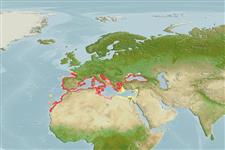Environment: milieu / climate zone / depth range / distribution range
Ökologie
seewasser demersal; tiefenbereich 0 - 120 m (Ref. 122887). Subtropical; 50°N - 10°N, 18°W - 42°E
Eastern Atlantic and Mediterranean Sea: including the Adriatic, Aegean and Black Sea, Portugal and Senegal. Has also been reported from southern Morocco, Mauritania, and Angola (Ref. 10813).
Size / Gewicht / Alter
Maturity: Lm ? range ? - ? cm
Max length : 17.0 cm TL Männchen/unbestimmt; (Ref. 3397); common length : 12.5 cm TL Männchen/unbestimmt; (Ref. 3397)
Rückenflossenstacheln (insgesamt) : 0; Rückenflossenweichstrahlen (insgesamt) : 53 - 59; Afterflossenweichstrahlen: 27 - 32; Wirbelzahl: 64 - 68. Ventrolateral skin-folds extending well beyond pectoral fins to anus. Lateral line branched. Back golden brown or greenish, belly silvery, head usually dark blue.
Found over shell-gravel and coarse sand bottoms (Ref. 6450). Minimum depth from Ref. 122877.
Life cycle and mating behavior
Geschlechtsreife | Fortpflanzung | Ablaichen | Eier | Fecundity | Larven
Quéro, J.-C., 1990. Ammodytidae. p. 920. In J. C. Quéro, J. C. Hureau, C. Karrer, A. Post and L. Saldanha (eds.) Check-list of the fishes of the eastern tropical Atlantic (CLOFETA). JNICT, Lisbon; SEI, Paris; and UNESCO, Paris. Vol. 2. (Ref. 10813)
IUCN Rote Liste Status (Ref. 130435: Version 2024-1)
Bedrohung für Menschen
Harmless
Nutzung durch Menschen
Fischereien: kommerziell
Tools
Can't connect to MySQL database fbquizv2. Errorcode: Too many connections
